|
In
the autumn of 1978 I was
into my fourth year
as a professional comedian, when I was offered the position of
Entertainment
Director on a ship going on a world cruise. After four weeks of
cruising
up and down the straights of Alaska, the highlight of which was
watching
my clothes go round in a laundrette in Ketchikan, I returned home. Or,
to
be more accurate, I returned 'home' homeless, and was put up
temporarily by my manager. What started as 'come round for dinner,'
turned into a nine-month stay. Long dinner.
Some
time during those months there was a
season
of Charlie Chaplin films, shown early evening each weekday on BBC2, I
think.
I had never seen Chaplin at the cinema, so a lot of these films were
new
to me. I would sit and watch them and laugh out loud, while my manager
and
his family would look at me in disbelief that I found any of it funny.
But
I knew this man Chaplin. I could instantly relate to the business he
was
performing, and I instinctively knew what he felt in his bones.
Strange
to say but, over the
years,
my capacity to laugh at his films has severely diminished, but my
fascination
for Chaplin 'the man' has grown stronger – hence the dedication
I have given to the research behind this book.When I first voiced my
intent
to publish a book about Chaplin, the consensus of opinion seemed to be:
“Surely, everything that could be written about Charlie Chaplin has
been written.” Well, I have to agree that there has been a voluminous
amount written about Chaplin, but so much of what is to be found in
magazine
and newspaper articles, and more recently on dedicated web-sites, is
just
junk. In these precis we often get the written equivalent of
“Chinese whispers.” One writer writes something about Chaplin,
another picks it up but doesn’t quite get it right, then the third
writer
re-writes it, a little more distorted, until the last writer has an
article
full of nonsense.
Within
these pages you will find
many quotes
from contemporary sources. My feelings are: “If a quote is a quote –
then quote it.” And you can quote me on that. The theory behind this
is that, the nearer a biographer can get to the original source, the
less
chance there is that the words have become corrupted by the process
mentioned.
Obviously this method does not eradicate the quote which was written as
a
lie in the first place. There is also a certain arrogance in
transposing
first-person quotes into the third person. If Chaplin says “I was
seventeen
when I joined the Karno Company,” and a biographer writes: “Chaplin
was seventeen when he joined the Karno Company,” then he is printing
an inaccuracy whilst intimating that his source is correct. That is
why,
in nearly all cases, I have revealed my sources.
There
have also been a lot of
glaring
inconsistencies written about Chaplin – most of them by Chaplin
himself.
When Chaplin sat down to write his biographies, it is doubtful that he
had
to hand the full list of dates he played whilst with the Karno Company;
and
so, as these numbered in the hundreds and occurred at the rate of up to
three
per night, he is rightly forgiven for any slight inaccuracies. One can
also
forgive Chaplin in instances where he has mistaken one London theatre
for
another. I, the author, was a club comedian for some fifteen years; in
which
time I too played thousands of dates at hundreds of venues. In my
instance
I had to find out the location of the venue in advance, plan my route,
and
then navigate my own way by car. Chaplin, however, had no such
responsibility.
All he had to do when playing in London, was to walk down to the Karno
Fun
Factory, in Camberwell, get aboard one of the special Karno buses, and
be
driven to the venue.When you’re not driving, you don’t always pay
attention to the route, and thus you can easily be unaware as to your
location.
Thus, when Chaplin says he was appearing at, say, Streatham, he might
well
have been appearing at Balham, and when he says “Woolwich,”
“Rotherithe” might well have been the venue. Failing that explanation,
the passage of time between the actual appearances and the writing of
his biographies must have clouded his memories.
|
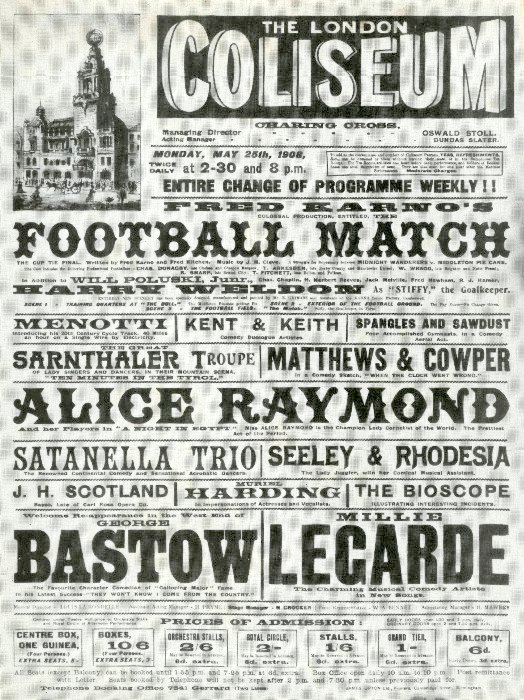
|
Fred Karno's
FOOTBALL MATCH
The London
Coliseum
1908
|
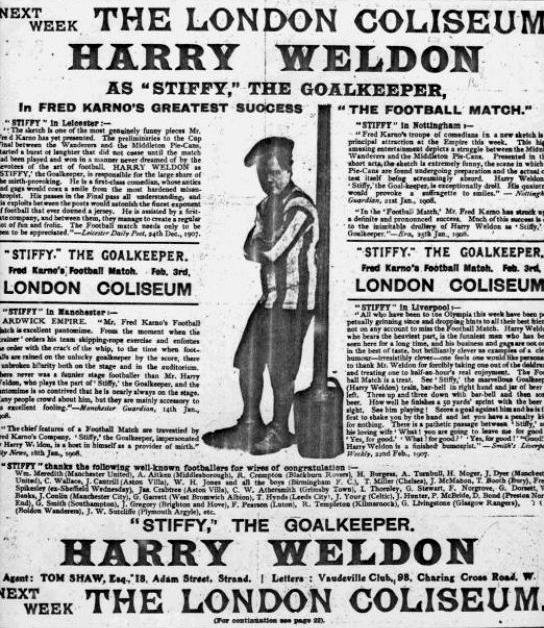 |
What further complicates accounts of
Chaplin’s movements is that many of these slip-ups have been carried
on by latter-day biographers, who didn’t have the recourse to check
them out. Past biographers have also underrated the time our eponymous
subject
spent in the Karno Company. In the biography Remember Fred Karno?,
the author relates that Chaplin joined the Karno Company during a run
of
the sketch The Football Match, after which he went into Jimmy
the
Fearless – thus omitting at
least half-a-dozen other sketches and
jumping forward more than two years in the twinkling of an eye. Other
authors
make similar leaps. Chaplin himself does not help. In his autobiography
he
omits to mention the first tour of three he made in The Football
Match,
thus giving the illusion that he was an immediate star in the Karno
Company.
Of the Karno sketch Jimmy
the Fearless, Chaplin makes
no
mention
whatsoever, despite his having played the lead role in it for some
nineteen
weeks.
This book has three aims:
The first is to destroy many
of
the myths
and legends which surround Chaplin’s stage career. Some can be dealt
with here and now:
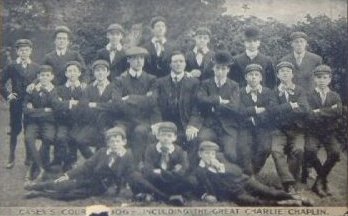 Firstly, there
never was a sketch or a sketch company called: “Fred Karno’s
Army [*1].” Neither was there a sketch or company called
“Fred Karno’s Circus.” This is important to note as,
in many previous accounts, Chaplin and Stan Laurel have been credited
with
being members of sketches and/or companies with these titles.
Paradoxically,
there were sketches called Casey’s Army
and Casey’s Circus but, whereas the latter two Casey
sketches
have been forgotten with time, the mythical Karno ones are the first to
trip
off the tongue whenever the name “Karno” is mentioned. There was
no such sketch as “Casey’s Court Circus.” There was
a sketch called Casey’s Court, which was set in a
courtyard,
and there was sketch called Casey’s Circus, which was
set in a mock-up of a circus ring. Firstly, there
never was a sketch or a sketch company called: “Fred Karno’s
Army [*1].” Neither was there a sketch or company called
“Fred Karno’s Circus.” This is important to note as,
in many previous accounts, Chaplin and Stan Laurel have been credited
with
being members of sketches and/or companies with these titles.
Paradoxically,
there were sketches called Casey’s Army
and Casey’s Circus but, whereas the latter two Casey
sketches
have been forgotten with time, the mythical Karno ones are the first to
trip
off the tongue whenever the name “Karno” is mentioned. There was
no such sketch as “Casey’s Court Circus.” There was
a sketch called Casey’s Court, which was set in a
courtyard,
and there was sketch called Casey’s Circus, which was
set in a mock-up of a circus ring.
Chaplin
never appeared in Casey’s Court.
Stan Laurel was never a member of Casey’s Court or any other
“Casey” Company.
|
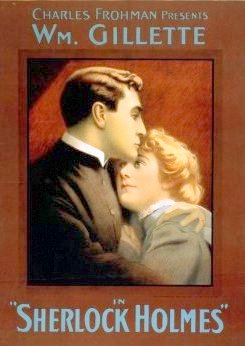
|
Other myths, such as The
Eight Lancashire Lads being in both Giddy Ostend and Cinderella,
at the London Hippodrome; Charlie being a wolf in Peter Pan;
when and where Charlie met Hetty Kelly; and when Chaplin was or wasn’t
caught on film for the first time, will be dealt with within the
narrative. His most repeated inaccuracy is his age. When writing of his
youth he constantly makes out is around twelve to eighteen months
younger than he actually was. For instance, when he became ‘Billy’ in Sherlock
Holmes he says he was twelve-and-a-half, whereas he was fourteen;
and when he became a principal comic in Karno’s The Football Match
he claims he was only seventeen, whereas he was all-but nineteen. One
can only surmise that he does this in an effort to be credited as the
youngest to do this and the youngest to do that. I think Chaplin must
have influenced the inept person who wrote the wording on the metal
plaque beneath his statue in Leicester Square, London, for it makes out
that he went into films when he was seventeen, whereas he was actually
twenty-four.
|
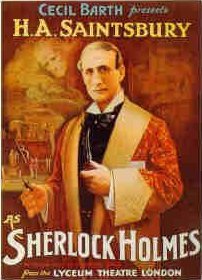
|
The second aim is to put
back many of the
pieces
of Chaplin’s early stage work which he chose to leave out, and to
remove
from others the paint with which he retouched them when he wished to
present
a different image. David Robinson, in Chaplin - His Life and Art,
gives the opinion that: “Chaplin was an honest and truthful
biographer.” I can’t agree. In my opinion, Chaplin has in many
instances distorted the truth, changed the facts, fabricated evidence,
and
deliberately left out information which doesn’t favour him. Also, the
dates and years he gives are so inaccurate that, in at least fifty per
cent
of cases, it is best to ignore them.
A second oft-used ruse by
Chaplin
is to
leave out anyone from his very early days who went on to become
famous.
For instance: if it weren’t for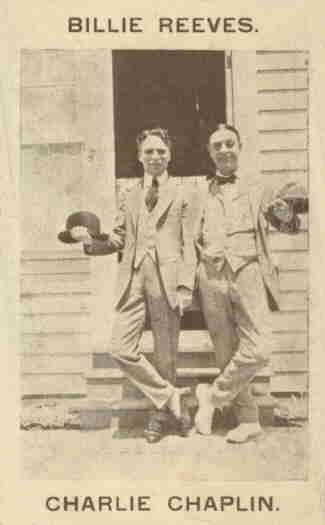 the caption on two photographs
– one in Chaplin’s autobiography, and the other in Chaplin -
My Life in Pictures, Stan Laurel would not have existed in
Chaplin’s
records, despite their having spent four years together in the Karno
Company.
More “neglected” stars, and relatives, will be revealed throughout
the book.
the caption on two photographs
– one in Chaplin’s autobiography, and the other in Chaplin -
My Life in Pictures, Stan Laurel would not have existed in
Chaplin’s
records, despite their having spent four years together in the Karno
Company.
More “neglected” stars, and relatives, will be revealed throughout
the book.
[Photo right shows Chaplin meeting
Billie
Reeves, but in Chaplin's
autobiography there is no mention of Reeves]
A
third recurring inaccuracy is for
Chaplin to
make out that events which happened only once, happened repeatedly. In
one
instance he describes escorting Hetty Kelly to the tube station to
attend
an audition, then goes on to make out this happened four days running.
In
another he says his mother spent a week on tour with them, then doesn’t
“pull out” and tells us it was four weeks. His best one regards
the time he was touring with the play Sherlock Holmes. Chaplin
recounts
his escapades in travelling with a pet rabbit, of which his guardian
adds:
“Once he let his rabbits run all over the landlady’s sitting room,
and of course they made a mess and annoyed the landlady.” Chaplin’s
version of “once” is that this happened every week for a whole
year.
The
third, and main, aim of the
book is
to present a chronological account of all of Chaplin’s stage
appearances.
This has been done in fragmented sections within the text, but then in
full
date-sheet form in the tables at the back of the book. After more than
six
years of research I am still unable to present these as one hundred per
cent
complete. Obviously, some minor errors will be found in them, but I
hope
that the reader will realise the enormity of the task and seek to help
to
improve the listing, rather than take pleasure in highlighting mistakes
or
holes. After all, in the ninety-years-plus since Chaplin actually made
these
appearances, this is the nearest to a definitive record you can
find.
In the article A
Comedian Sees
the
World, written in September 1933, Chaplin himself revealed.
I am tired of love and people
and
like all
egocentrics I turn to myself. I want to live in my youth again, to
capture
the moods and sensations of childhood, so remote from me now - so
unreal
- almost like a dream. I need to turn back time; to venture into the
blurred
past and bring it into focus.
So, good readers, let us
venture into the
blurred
past and bring it into focus.
|

 Firstly, there
never was a sketch or a sketch company called: “Fred Karno’s
Army [*1].” Neither was there a sketch or company called
“Fred Karno’s Circus.” This is important to note as,
in many previous accounts, Chaplin and Stan Laurel have been credited
with
being members of sketches and/or companies with these titles.
Paradoxically,
there were sketches called Casey’s Army
and Casey’s Circus but, whereas the latter two Casey
sketches
have been forgotten with time, the mythical Karno ones are the first to
trip
off the tongue whenever the name “Karno” is mentioned. There was
no such sketch as “Casey’s Court Circus.” There was
a sketch called Casey’s Court, which was set in a
courtyard,
and there was sketch called Casey’s Circus, which was
set in a mock-up of a circus ring.
Firstly, there
never was a sketch or a sketch company called: “Fred Karno’s
Army [*1].” Neither was there a sketch or company called
“Fred Karno’s Circus.” This is important to note as,
in many previous accounts, Chaplin and Stan Laurel have been credited
with
being members of sketches and/or companies with these titles.
Paradoxically,
there were sketches called Casey’s Army
and Casey’s Circus but, whereas the latter two Casey
sketches
have been forgotten with time, the mythical Karno ones are the first to
trip
off the tongue whenever the name “Karno” is mentioned. There was
no such sketch as “Casey’s Court Circus.” There was
a sketch called Casey’s Court, which was set in a
courtyard,
and there was sketch called Casey’s Circus, which was
set in a mock-up of a circus ring.  the caption on two photographs
– one in Chaplin’s autobiography, and the other in Chaplin -
My Life in Pictures, Stan Laurel would not have existed in
Chaplin’s
records, despite their having spent four years together in the Karno
Company.
More “neglected” stars, and relatives, will be revealed throughout
the book.
the caption on two photographs
– one in Chaplin’s autobiography, and the other in Chaplin -
My Life in Pictures, Stan Laurel would not have existed in
Chaplin’s
records, despite their having spent four years together in the Karno
Company.
More “neglected” stars, and relatives, will be revealed throughout
the book.





